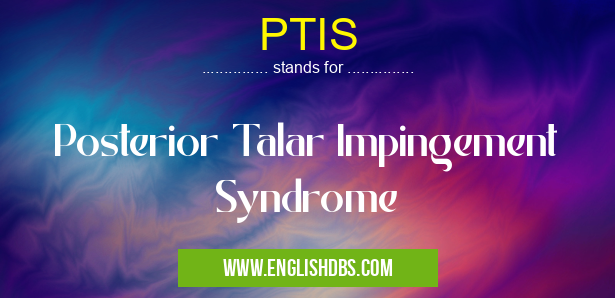What does PTIS mean in PHYSIOLOGY
Posterior Talar Impingement Syndrome (PTIS) is a medical condition that occurs when the back of the talus bone, located in the ankle, becomes compressed or hits against other bones in the foot. This friction and compression can cause pain, swelling, and limited mobility.

PTIS meaning in Physiology in Medical
PTIS mostly used in an acronym Physiology in Category Medical that means Posterior Talar Impingement Syndrome
Shorthand: PTIS,
Full Form: Posterior Talar Impingement Syndrome
For more information of "Posterior Talar Impingement Syndrome", see the section below.
» Medical » Physiology
Essential Questions and Answers on Posterior Talar Impingement Syndrome in "MEDICAL»PHYSIOLOGY"
What causes PTIS?
PTIS is usually caused by changes in the shape of bones or joints due to arthritis and wear-and-tear from overuse injuries. It may also be caused by structural deformities such as an unusually high anterior talofibular ligament that can interfere with free joint movement, which can lead to posterior impingement.
What are some symptoms of PTIS?
Common symptoms of PTIS include pain during activity and at rest in the ankle joint, swelling around the back of the ankle, restricted range of motion due to associated stiffness, tenderness along the joint line at the back of the ankle, and grinding sensations or crepitus when moving your foot or ankle.
How is PTIS diagnosed?
To diagnose PTIS, a doctor will conduct a physical examination to identify tenderness and assess range of motion. Imaging tests such as X-rays or MRI scans may also be used to confirm diagnosis and help determine treatment options.
What are some treatments for PTIS?
Treatment for PTIS often includes rest and modification of activities that aggravate symptoms. Physical therapy may be recommended to stretch and strengthen muscles surrounding affected joints. Non-steroidal anti-inflammatory drugs (NSAIDs) can also provide relief from pain and inflammation associated with PTIS. In more severe cases, surgery may be necessary to repair any damage to tissues or reposition bones in order to reduce friction causing impingement.
How long does it take for treatment for PTIS?
The length of treatment depends on severity of symptoms. Conservative treatments such as rest, medications, physical therapy exercises may take several weeks before achieving desired results. Surgery typically requires longer recovery time than conservative treatments; however it can provide more immediate relief from pain than non-surgical methods.
Final Words:
Posterior Talar Impingement Syndrome (PTIS) is a painful condition that affects mobility in your ankle joint due to excessive pressure on this area caused by various factors including structural deformities or overuse injuries. Symptoms can vary from person to person but generally include pain during activity and at rest with swelling around the back of your ankle. Diagnosis involves a physical exam combined with imaging tests while treatments range from rest and medications to more serious measures such as surgery depending on severity of symptoms.
